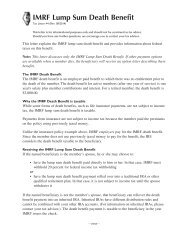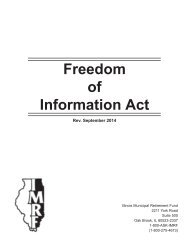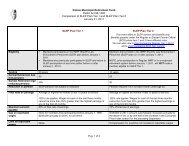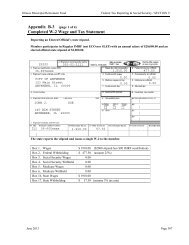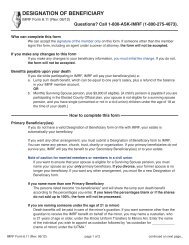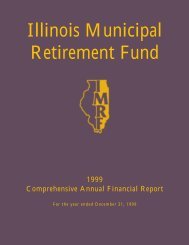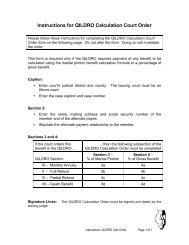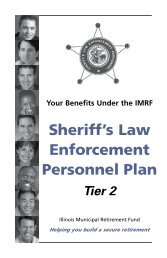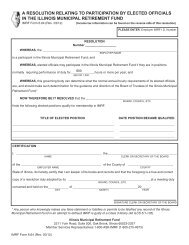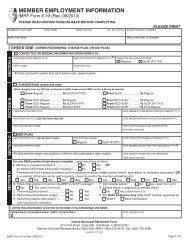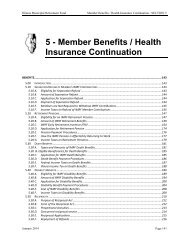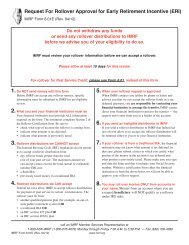Insights for Retired Members of IMRF
Insights for Retired Members of IMRF
Insights for Retired Members of IMRF
Create successful ePaper yourself
Turn your PDF publications into a flip-book with our unique Google optimized e-Paper software.
<strong>for</strong><br />
retiring<br />
members<br />
<strong>Insights</strong><br />
A detailed guide to<br />
the benefits available to<br />
<strong>Retired</strong> <strong>Members</strong> <strong>of</strong><br />
the Illinois Municipal<br />
Retirement Fund. Also<br />
included is in<strong>for</strong>mation<br />
on state and federal<br />
taxes, Social Security,<br />
and general in<strong>for</strong>mation<br />
about <strong>IMRF</strong>.<br />
Locally funded,<br />
financially sound<br />
BENEFIT TYPES<br />
40 & 41
Table <strong>of</strong> Contents<br />
Introduction. ............................................. i<br />
Explanation <strong>of</strong> terms used in this booklet. ...................... 1<br />
Your first pension payment. ................................. 4<br />
Certificate <strong>of</strong> Benefits. ..................................... 7<br />
Annual Benefit Statement................................... 7<br />
Member Access. .......................................... 8<br />
Designation <strong>of</strong> Beneficiary <strong>for</strong> Annuitants (Form 6.11A) .......... 9<br />
Federal Income Tax In<strong>for</strong>mation. ............................ 11<br />
State income tax . ........................................ 16<br />
Form W-4P (Withholding Certificate <strong>for</strong> pension payments). ...... 17<br />
Pension increases ........................................ 19<br />
Supplemental pension payment.......................... 19<br />
Returning to work........................................ 21<br />
<strong>IMRF</strong> death benefits. ..................................... 22<br />
Surviving spouse benefits. .............................. 22<br />
Address changes. ........................................ 24<br />
Direct Deposit <strong>of</strong> your pension payment ...................... 25<br />
Representative payees. .................................... 28<br />
Conservator, guardian, or trustee ............................ 29<br />
Power <strong>of</strong> Attorney. ....................................... 29<br />
Social Security and <strong>IMRF</strong>. ................................. 30<br />
General In<strong>for</strong>mation about <strong>IMRF</strong>. ........................... 33<br />
IRS Tax Publications. ..................................... 34<br />
Revised January 2013
This page left intentionally blank
Introduction<br />
The purpose <strong>of</strong> this booklet is to provide you—a retiring <strong>IMRF</strong><br />
member—with in<strong>for</strong>mation about your <strong>IMRF</strong> pension benefits.<br />
The in<strong>for</strong>mation provided in this booklet is general. If you have<br />
specific questions regarding your individual pension, please contact an<br />
<strong>IMRF</strong> Member Services Representative at 1-800-ASK-<strong>IMRF</strong><br />
(1-800-275-4673) Monday through Friday, 7:30 a.m. to 5:30 p.m.<br />
You can also find in<strong>for</strong>mation about <strong>IMRF</strong> on the web at<br />
www.imrf.org.<br />
The in<strong>for</strong>mation contained in this booklet was accurate<br />
at the time <strong>of</strong> printing. All in<strong>for</strong>mation is subject<br />
to change without notice.<br />
<strong>Insights</strong>: For Retiring <strong>Members</strong><br />
i
This page left intentionally blank
Explanation <strong>of</strong> terms used in this booklet<br />
Listed below are some <strong>of</strong> the terms used in this booklet.<br />
Annuitant<br />
A person receiving an <strong>IMRF</strong> pension or surviving spouse pension.<br />
Beneficiary<br />
When a member joins <strong>IMRF</strong>, he/she completes <strong>IMRF</strong> Form 6.11,<br />
“Designation <strong>of</strong> Beneficiary.” Also, <strong>IMRF</strong> members complete a new<br />
designation <strong>of</strong> beneficiary <strong>for</strong>m after they retire. The beneficiary is<br />
the person designated to receive any benefits payable upon the death<br />
<strong>of</strong> the member.<br />
Civil Union<br />
Public Act 96-1513 was effective June 1, 2011, and conferred the<br />
rights <strong>of</strong> marriage available under Illinois Law to parties to a civil<br />
union. There<strong>for</strong>e, the partner <strong>of</strong> a member who enters into a civil<br />
union will have the same rights as a spouse <strong>of</strong> a married member.<br />
Divorce<br />
The dissolution <strong>of</strong> a marriage or civil union.<br />
Effective Date <strong>of</strong> Retirement<br />
The date a member is first entitled to receive pension benefits.<br />
<strong>IMRF</strong> pensions start as <strong>of</strong> the first day <strong>of</strong> the month after<br />
participation terminates. The effective date, not the date <strong>of</strong> the first<br />
payment, is important when determining how you should calculate<br />
the taxable portion <strong>of</strong> your <strong>IMRF</strong> pension payments <strong>for</strong> federal<br />
income tax purposes.<br />
Eligible Spouse<br />
If you and your spouse were married or in a civil union <strong>for</strong> more<br />
than one year when you stopped participating in <strong>IMRF</strong>, your<br />
spouse is eligible <strong>for</strong> an <strong>IMRF</strong> surviving spouse pension. If your<br />
spouse pre-deceases you and you remarry or enter into a new civil<br />
<strong>Insights</strong>: For Retiring <strong>Members</strong><br />
1
union, your second spouse would be eligible <strong>for</strong> a surviving spouse<br />
pension if you are married or in a civil union <strong>for</strong> at least one year<br />
prior to your death and you retired on or after March 26, 1992.<br />
Employer Death Benefit<br />
A $3,000 benefit, funded by <strong>IMRF</strong> employers, usually is payable<br />
upon the death <strong>of</strong> a retired member.<br />
Exclusion<br />
That portion <strong>of</strong> your monthly benefit payment that is not subject<br />
to federal income tax. For example, if your monthly pension is<br />
$100 and your monthly exclusion amount is $1.50, the $1.50 is not<br />
subject to (or is excluded from) federal income tax.<br />
<strong>IMRF</strong> calculates the monthly exclusion amount using the<br />
“Simplified Method.” You can find more in<strong>for</strong>mation about this<br />
method on page 12 <strong>of</strong> this booklet, and in IRS Publication 575,<br />
“Pension and Annuity Income.”<br />
Previously taxed contributions<br />
If a member made contributions to <strong>IMRF</strong> be<strong>for</strong>e 1984, those<br />
contributions are previously taxed. That is, the money used to pay<br />
those contributions has already been subject to federal income tax—<br />
the member paid taxes on the money used to make them.<br />
A portion <strong>of</strong> a member’s retirement benefit (and in some cases, a<br />
survivor’s benefit) is a return <strong>of</strong> the member’s own contributions.<br />
If those contributions are “previously taxed,” then that portion<br />
<strong>of</strong> the benefit payment is not subject to federal income tax. (See<br />
explanation above.)<br />
Tax deferred contributions<br />
If a member made contributions to <strong>IMRF</strong> in 1984 or later, the<br />
money used to pay those contributions has not been subject to<br />
federal income tax. The contributions were deducted from the<br />
member’s pay checks without being taxed. There<strong>for</strong>e, the member<br />
has not been taxed on the money used to make those contributions.<br />
2<br />
<strong>Insights</strong>: For Retiring <strong>Members</strong>
A portion <strong>of</strong> a member’s retirement benefit (and in some cases,<br />
a survivor’s benefit) is a return <strong>of</strong> the member’s own member<br />
contributions. If those contributions are “tax deferred,” then that<br />
portion <strong>of</strong> the benefit payment is subject to federal income tax.<br />
<strong>Insights</strong>: For Retiring <strong>Members</strong><br />
3
Your first pension payment<br />
Your first pension payment may include benefits <strong>for</strong> more than<br />
one month. Depending upon your individual circumstances, your<br />
first payment may also include a refund <strong>for</strong> overpaid contributions.<br />
Likewise, if you have underpaid, a deduction was made from your<br />
first pension payment.<br />
You may also receive separate payments <strong>for</strong> refunds <strong>of</strong>:<br />
• Voluntary additional contributions and interest<br />
• Surviving spouse pension contributions and interest<br />
• Sheriff’s Law En<strong>for</strong>cement Personnel (SLEP) program<br />
contributions and interest.<br />
For in<strong>for</strong>mation on taxation <strong>of</strong> these refunds, please turn to page 11.<br />
Direct Deposit <strong>of</strong> your pension payment<br />
You will receive your pension payment through Direct Deposit. <strong>IMRF</strong><br />
verifies the routing and account numbers <strong>of</strong> your financial institution<br />
on your direct deposit <strong>for</strong>m. If the verification is completed:<br />
• Be<strong>for</strong>e we process your first payment, that payment will be<br />
directly deposited.<br />
• After we process your first payment, you will receive a check<br />
<strong>for</strong> your first payment, and subsequent payments will be<br />
directly deposited.<br />
Additional contributions<br />
If you chose to make voluntary additional contributions, you had<br />
two options. You could have applied the additional contributions<br />
plus interest to a monthly annuity payable <strong>for</strong> life, or you could have<br />
withdrawn the entire amount in a lump sum.<br />
4<br />
<strong>Insights</strong>: For Retiring <strong>Members</strong>
Spouse contribution refund<br />
You will receive a refund <strong>of</strong> your spouse contributions plus interest<br />
if you were single, widowed, or divorced when you retired, or if<br />
you were married or in a civil union, but the marriage or civil union<br />
occurred less than one year prior to the date you stopped participating<br />
in <strong>IMRF</strong> (that is, you have no “eligible spouse”–see page 1) .<br />
SLEP<br />
Participants in the SLEP program who did not qualify <strong>for</strong> the SLEP<br />
pension and retired under the regular <strong>IMRF</strong> pension program will<br />
receive a refund <strong>of</strong> their SLEP program contributions (2% be<strong>for</strong>e<br />
June 1, 2006, 3% after June 1, 2006) plus interest. SLEP program<br />
contributions were the additional contributions participants in the<br />
program were required to make while working.<br />
Retirement packet<br />
Every retiring <strong>IMRF</strong> member receives a copy <strong>of</strong> this booklet<br />
(“<strong>Insights</strong>: For Retiring <strong>Members</strong>,”) as well as the following:<br />
1) <strong>IMRF</strong> Form 6.11A, “Designation <strong>of</strong> Beneficiary <strong>for</strong><br />
Annuitants” (also available in Member Access at<br />
www.imrf.org/myimrf)<br />
2) Form W-4P, “Withholding Certificate <strong>for</strong> Pension or Annuity<br />
Payments” (also available in Member Access at<br />
www.imrf.org/myimrf)<br />
3) “Are You Planning to Continue Your Employer’s Health<br />
Insurance?,” a booklet about continuing your health insurance<br />
through your employer. The booklet includes <strong>IMRF</strong> Form<br />
7.10, “Health Insurance Continuation Through Employer -<br />
Premium Deduction Authorization”<br />
4) “Are You Looking <strong>for</strong> In<strong>for</strong>mation About <strong>IMRF</strong>-endorsed<br />
Health Insurance Programs?,” a booklet on choosing a health<br />
care plan endorsed by the <strong>IMRF</strong> Board <strong>of</strong> Trustees.<br />
Continued on next page...<br />
<strong>Insights</strong>: For Retiring <strong>Members</strong><br />
5
5) “Returning to Work After Retirement” booklet: in<strong>for</strong>mation<br />
on the effect returning to work will have on your <strong>IMRF</strong><br />
pension<br />
6) Additional mailings <strong>for</strong>m<br />
7) A reply envelope<br />
Enter your beneficiary in<strong>for</strong>mation<br />
and your tax withholding<br />
instructions in Member Access!<br />
Form 6.11A, Designation <strong>of</strong> Beneficiary<br />
<strong>for</strong> Annuitants and Form W-4P,<br />
Withholding Certificate <strong>for</strong> Monthly<br />
Annuity Payments can be completed<br />
quickly and easily online in your Member<br />
Access account:<br />
www.imrf.org/myimrf<br />
(You can also complete and return the paper <strong>for</strong>ms<br />
6.11A and W-4P included in this retirement packet.)<br />
6<br />
<strong>Insights</strong>: For Retiring <strong>Members</strong>
Certificate <strong>of</strong> Benefits<br />
This green and white document, which is mailed separately, contains<br />
useful in<strong>for</strong>mation and should be kept with your important papers.<br />
The Certificate <strong>of</strong> Benefits includes:<br />
• The amount <strong>of</strong> your monthly pension<br />
• The effective date <strong>of</strong> your pension<br />
• The annual increase you can expect to receive next January and<br />
every January thereafter.<br />
As a retired member, you are guaranteed the return <strong>of</strong> all pension<br />
contributions you made and interest which was credited to the date <strong>of</strong><br />
your retirement. The Certificate <strong>of</strong> Benefits explains this guaranteed<br />
amount. If you should die be<strong>for</strong>e you receive the guaranteed amount,<br />
the balance will be paid as part <strong>of</strong> a surviving spouse pension or as a<br />
lump sum death benefit to your beneficiaries (see page 22).<br />
Also included in the Certificate is in<strong>for</strong>mation regarding your<br />
survivor’s benefit and amounts payable at your death to your spouse<br />
and/or beneficiaries. The last section, “Income Tax In<strong>for</strong>mation,”<br />
explains how your pension will be taxed.<br />
Annual Benefit Statement<br />
You will receive an annual benefit statement from <strong>IMRF</strong> every year in<br />
late November. These statements include in<strong>for</strong>mation such as:<br />
• The amount <strong>of</strong> your annual 3% increase<br />
• Current beneficiary in<strong>for</strong>mation<br />
• The estimated amount <strong>of</strong> your next year’s 13th payment.<br />
Please note: You will not receive a statement in the first year you<br />
retired—you will begin receiving statements starting the year after<br />
you retired. For example, if you retired during 2013, you will receive<br />
your first annual benefit statement from <strong>IMRF</strong> in November 2014.<br />
<strong>Insights</strong>: For Retiring <strong>Members</strong><br />
7
Member Access<br />
With Member Access, you can securely view up-to-date, detailed<br />
in<strong>for</strong>mation about your <strong>IMRF</strong> account.<br />
When you have an online Member Access account, you can:<br />
• View your pension payment history and payment detail<br />
• View and update beneficiary in<strong>for</strong>mation<br />
• Change your federal tax withholding or your<br />
Direct Deposit instructions<br />
• Change your contact in<strong>for</strong>mation (including your address<br />
and phone number)<br />
• View documents such as your annual 1099R tax <strong>for</strong>ms and your<br />
yearly benefit statement—<strong>of</strong>ten earlier than you receive paper<br />
copies in the mail<br />
• Register <strong>for</strong> retiree workshops<br />
How to sign up<br />
Applying <strong>for</strong> an account is easy—go to www.imrf.org/myimrf.<br />
(For your security and privacy, you cannot request or receive a user ID<br />
and password by phone or email.)<br />
8<br />
<strong>Insights</strong>: For Retiring <strong>Members</strong>
Designation <strong>of</strong> Beneficiary <strong>for</strong> Annuitants<br />
(Form 6.11A)<br />
While you were working as a participating member <strong>of</strong> <strong>IMRF</strong>, you<br />
completed Form 6.11, “Designation <strong>of</strong> Beneficiary.” On this <strong>for</strong>m, you<br />
named your beneficiary(ies) <strong>for</strong> the <strong>IMRF</strong> death benefit.<br />
As an <strong>IMRF</strong> retiree, you have different <strong>IMRF</strong> death benefits, and must<br />
complete a different <strong>for</strong>m: Form 6.11A, Designation <strong>of</strong> Beneficiary <strong>for</strong><br />
Annuitants.<br />
State law determines if the surviving spouse <strong>of</strong> a retired member<br />
will receive a surviving spouse pension. However, retired members<br />
are free to name beneficiaries <strong>for</strong> the $3,000 lump sum death<br />
benefit. You can name your spouse as co-beneficiary with other cobeneficiaries.<br />
As a co-beneficiary, your spouse would share the <strong>IMRF</strong><br />
$3,000 death benefit. You can also name any person, whether or not<br />
a relative, or any church, trust, charity, or organization as primary<br />
beneficiary(ies).<br />
If you do not have a valid Designation <strong>of</strong> Beneficiary <strong>for</strong>m on file<br />
with <strong>IMRF</strong>, the lump sum death benefit will be paid to your estate.<br />
Naming other beneficiaries<br />
Married members, members in a civil union, and single members<br />
can name any person, church, charity or organization as primary and<br />
secondary beneficiary(ies). Secondary beneficiary(ies) receive the<br />
death benefit if no primary beneficiary survives.<br />
Changes<br />
You may change your primary and secondary beneficiaries at any<br />
time. The designation <strong>for</strong>m with the most current date revokes any<br />
previous beneficiary designations. Be sure to keep your designation<br />
<strong>of</strong> beneficiary <strong>for</strong>m current. Changes in marital or civil union status or<br />
the death <strong>of</strong> a person named on the designation <strong>for</strong>m are examples <strong>of</strong><br />
when a new designation <strong>for</strong>m should be filed with <strong>IMRF</strong> promptly.<br />
<strong>Insights</strong>: For Retiring <strong>Members</strong><br />
9
If you wish to change your beneficiary designation, you can sign in to<br />
your Member Access account or you can call or write <strong>IMRF</strong> to request<br />
additional designation <strong>of</strong> beneficiary <strong>for</strong>ms. (See page 33.) You can<br />
also download a PDF <strong>of</strong> Form 6.11A at www.imrf.org.<br />
You can complete<br />
your designation <strong>of</strong><br />
beneficiary <strong>for</strong>m quickly<br />
and easily through<br />
your Member Access<br />
account at:<br />
www.imrf.org/myimrf.<br />
Choose Secure Online<br />
Forms under the Tools<br />
tab.<br />
Confidentiality<br />
To protect your privacy, the in<strong>for</strong>mation contained on your <strong>IMRF</strong><br />
Designation <strong>of</strong> Beneficiary <strong>for</strong>m is deemed confidential. Only you<br />
or those individuals you approve may obtain in<strong>for</strong>mation from this<br />
record.<br />
Please Note: The <strong>IMRF</strong> member is the only person who<br />
may sign and/or change a Designation <strong>of</strong> Beneficiary<br />
(Form 6.11A). Any other representative acting on behalf <strong>of</strong><br />
the member, including a Power <strong>of</strong> Attorney, guardian, conservator,<br />
trustee, or representative payee, cannot change or<br />
sign a designation <strong>of</strong> beneficiary. If anyone other than the<br />
member signs or changes Form 6.11A, it is invalid and<br />
will not be accepted.<br />
10<br />
<strong>Insights</strong>: For Retiring <strong>Members</strong>
Federal Income Tax In<strong>for</strong>mation<br />
(You may wish to refer to the definitions provided on pages 1 and 2<br />
be<strong>for</strong>e and while reading this section.)<br />
Withholding on Lump-Sum Distributions<br />
The Federal Unemployment Compensation Amendments Act <strong>of</strong> 1992<br />
affects how <strong>IMRF</strong> must handle payments <strong>of</strong> lump-sum distributions.<br />
According to this act, a “lump-sum distribution” is:<br />
• Refund <strong>of</strong> surviving spouse contributions plus interest upon<br />
retirement if the retiree has no eligible spouse (see page 1 <strong>for</strong> a<br />
definition <strong>of</strong> “eligible spouse”)<br />
• Refund <strong>of</strong> SLEP contributions plus interest upon retirement if<br />
the retiree does not qualify <strong>for</strong> a SLEP pension<br />
• Lump-sum death benefit<br />
• $3,000 death payment<br />
A member or spouse by marriage receiving a lump-sum distribution<br />
has the right to “roll over” the taxable portion <strong>of</strong> the payment directly<br />
to an IRA or another qualified pension plan. If he or she does not<br />
directly roll over the payment, then <strong>IMRF</strong> must withhold 20 percent<br />
<strong>of</strong> the taxable portion <strong>of</strong> distributions. A “direct rollover” is a payment<br />
by <strong>IMRF</strong> to the IRA or other qualified pension plan.<br />
The 20 percent withholding rate is fixed by law. Individual members<br />
may apply the 20 percent to their tax liability <strong>for</strong> that year. The actual<br />
amount owed may be larger or smaller and will vary <strong>for</strong> individual<br />
members.<br />
PA 96-1513, (Illinois Religious Freedom Protection and Civil Union<br />
Act, effective June 1, 2011) gives couples in a civil union the same<br />
state <strong>of</strong> Illinois rights and protections entitled to married couples.<br />
Under current federal law, spouses by civil union and non-spouse<br />
beneficiaries may only roll over lump-sum distributions to an inherited<br />
IRA. For amounts not rolled over, <strong>IMRF</strong> will withhold 20%.<br />
<strong>Insights</strong>: For Retiring <strong>Members</strong><br />
11
Federal taxes<br />
Your retirement pension, beginning with your first payment, is<br />
subject to federal income tax. However, if in the past you paid federal<br />
income tax on your pension contributions, that part <strong>of</strong> your pension<br />
representing a return <strong>of</strong> those contributions is not taxable under the<br />
Internal Revenue Code.<br />
If you have no previously taxed contributions (i.e., all <strong>of</strong> your<br />
contributions are tax-deferred contributions), your pension will be<br />
fully taxable beginning with the first payment.<br />
Simplified Method<br />
<strong>IMRF</strong> will report the taxable amount <strong>of</strong> your pension using the<br />
Simplified Method. The Simplified Method provides a specific dollar<br />
amount <strong>of</strong> each monthly pension payment that is not subject to federal<br />
income tax.<br />
That dollar amount is determined by dividing the pension cost (from<br />
your Certificate <strong>of</strong> Benefits) by the number <strong>of</strong> pension payments<br />
you can expect to receive. The pension cost <strong>for</strong> IRS purposes is<br />
the total previously taxed contributions. This amount appears on<br />
your Certificate <strong>of</strong> Benefits under the section titled “Income Tax<br />
In<strong>for</strong>mation.”<br />
The monthly exclusion amount remains in effect until you recover all<br />
<strong>of</strong> your previously taxed contributions. Thereafter, your pension is<br />
fully taxable. <strong>IMRF</strong> will notify you when all <strong>of</strong> your previously taxed<br />
contributions have been recovered.<br />
12<br />
<strong>Insights</strong>: For Retiring <strong>Members</strong>
Annual Tax Statement - Form 1099-R<br />
Every January <strong>IMRF</strong> will provide you with a 1099-R tax statement<br />
showing the gross amount <strong>of</strong> benefits you received the previous year.<br />
This <strong>for</strong>m also will indicate the taxable portion <strong>of</strong> your pension as<br />
well as any federal income tax that may have been withheld from your<br />
payments. The in<strong>for</strong>mation on this <strong>for</strong>m should be used <strong>for</strong> filing your<br />
federal and state income tax returns.<br />
Filing federal taxes<br />
You must use Internal Revenue Service Form 1040 or Form 1040A,<br />
“U.S. Individual Income Tax Return,” when you file your annual<br />
federal tax return. You cannot use Form 1040EZ.<br />
In order to properly report your <strong>IMRF</strong> pension, report the total amount<br />
received on the line designated <strong>for</strong> pensions and annuities. This was<br />
line 16a on the 2011 Form 1040 or line 12a on the 2011 Form 1040A.<br />
The pension lines <strong>of</strong> these <strong>for</strong>ms have two boxes. “Box a” is <strong>for</strong> the<br />
gross amount <strong>of</strong> pension received, and “Box b” is <strong>for</strong> the taxable<br />
portion <strong>of</strong> your pension payments.<br />
For more in<strong>for</strong>mation<br />
A complete explanation <strong>of</strong> the Simplified Method can be found in IRS<br />
Publication 575. For a list <strong>of</strong> IRS publications which explain how to<br />
figure the taxable amount <strong>of</strong> an <strong>IMRF</strong> pension, see page 34.<br />
<strong>IMRF</strong> is not in a position to <strong>of</strong>fer tax assistance; if you have specific<br />
questions about the Simplified Method or general questions about the<br />
taxability <strong>of</strong> your pension, please contact the Internal Revenue Service<br />
or your tax consultant.<br />
<strong>Insights</strong>: For Retiring <strong>Members</strong><br />
13
This page left intentionally blank<br />
14<br />
<strong>Insights</strong>: For Retiring <strong>Members</strong>
Credit <strong>for</strong> the elderly or the disabled<br />
The IRS allows a credit <strong>for</strong> eligible tax payers. Eligible taxpayers are<br />
either:<br />
• Age 65 or greater<br />
or<br />
• Totally and permanently disabled<br />
In addition, your adjusted gross income must be below IRS limits.<br />
To see if you are eligible <strong>for</strong> this credit, you can request IRS<br />
Publication 524, “Credit <strong>for</strong> the Elderly or the Disabled,” by calling<br />
1-800-TAX-FORM (800-829-3676) or by discussing this with your<br />
tax advisor.<br />
Are you under age 59-½ and continuing to work<br />
<strong>for</strong> your <strong>IMRF</strong> employer?<br />
Member contributions to <strong>IMRF</strong> are considered tax-deferred as<br />
retirement savings. Most tax-deferred retirement savings are subject<br />
to a 10% early withdrawal tax when taken out <strong>of</strong> the retirement plan<br />
be<strong>for</strong>e the recipient is age 59-½. However, there is an exception to<br />
this early withdrawal tax <strong>for</strong> <strong>IMRF</strong> pension payments that begin no<br />
earlier than age 55 (age 50 <strong>for</strong> public safety employees)—if you have<br />
totally separated from service with your last <strong>IMRF</strong> employer.<br />
If you do not separate from service with your last <strong>IMRF</strong> employer,<br />
and instead continue to work <strong>for</strong> this employer in a non-participating<br />
position while receiving your pension payments at the same time, you<br />
are not eligible <strong>for</strong> this exception. In this situation, you must pay the<br />
additional 10% early withdrawal tax on your monthly <strong>IMRF</strong> pension<br />
payments. You will be required to pay this additional tax until you reach<br />
age 59-½ or until you leave employment with your <strong>IMRF</strong> employer.<br />
Please note: The above situation assumes that you have already<br />
contacted <strong>IMRF</strong> and verified that you could continue to work<br />
after retirement without your pension being suspended.<br />
<strong>Insights</strong>: For Retiring <strong>Members</strong><br />
15
State income tax<br />
Illinois state tax<br />
Your pension is not subject to Illinois state income tax. If your state<br />
<strong>of</strong> residence is other than Illinois, you should check with that state’s<br />
department <strong>of</strong> revenue to find out if your pension is subject to state tax<br />
and how your pension income must be reported on your state income<br />
tax return.<br />
Filing Illinois state income tax returns<br />
Because your <strong>IMRF</strong> pension is not subject to Illinois state income<br />
tax, you should enter the federally taxed portion <strong>of</strong> your pension<br />
(from your Form 1099-R) as a subtraction on Form IL-1040, “Illinois<br />
Individual Income Tax Return.” This line is designated as “income<br />
received from Social Security benefits and certain retirement plans...”<br />
(line 5 on the 2011 IL-1040).<br />
In order to show that your <strong>IMRF</strong> pension is subtractable, you must<br />
include a copy <strong>of</strong> page one <strong>of</strong> your U.S. 1040 or 1040A <strong>for</strong>m with<br />
your Illinois state income tax return. If you fail to attach a copy <strong>of</strong> the<br />
U.S. 1040 or 1040A, your entry will not be allowed.<br />
Please note: Even though you may have no other taxable income, the<br />
Illinois Department <strong>of</strong> Revenue requires that you file a return if you<br />
are an Illinois resident.<br />
16<br />
<strong>Insights</strong>: For Retiring <strong>Members</strong>
Form W-4P:<br />
Withholding Certificate <strong>for</strong> pension payments<br />
Because pension payments are immediately taxable, you are required by<br />
the Internal Revenue Service to submit a completed Form W-4P to <strong>IMRF</strong>.<br />
Amount <strong>of</strong> withholding<br />
<strong>IMRF</strong> is not in a position to <strong>of</strong>fer tax assistance, and there<strong>for</strong>e, cannot<br />
determine the amount <strong>of</strong> withholding that is right <strong>for</strong> a particular<br />
member. If you are not sure how much money should be withheld<br />
from your pension payments in order to meet your federal tax<br />
obligation, you should talk with your tax consultant.<br />
Withholding without Form W-4P<br />
If you do not return Form W-4P to <strong>IMRF</strong> and your pension during<br />
2013 exceeds $1,667 a month, <strong>IMRF</strong> is required by law to withhold<br />
an amount based upon the IRS tax tables.<br />
The amount withheld will be based on a married individual claiming<br />
three withholding allowances. If your monthly pension payments<br />
during 2013 are $1,667 or less and you have no withholding request<br />
on file, no federal tax will be withheld. The dollar amount ($1,667)<br />
will be adjusted each year by the IRS.<br />
Because Illinois does not tax pension payments, <strong>IMRF</strong> does not<br />
withhold <strong>for</strong> Illinois income tax. <strong>IMRF</strong> will not honor any request to<br />
withhold <strong>for</strong> states outside <strong>of</strong> Illinois.<br />
You can complete Form W-4P quickly and easily through your<br />
Member Access account at www.imrf.org/myimrf. You can also<br />
request Form W-4P from one <strong>of</strong> our Member Services Representatives<br />
at 1-800-ASK-<strong>IMRF</strong> (1-800-275-4673) or download a PDF <strong>of</strong> this<br />
<strong>for</strong>m at www.imrf.org.<br />
Your withholding can be changed at any time simply by completing<br />
a new Form W-4P. Generally, if we receive your revised Form W-4P<br />
be<strong>for</strong>e we process your next payment, the change will be effective <strong>for</strong><br />
that payment.<br />
<strong>Insights</strong>: For Retiring <strong>Members</strong><br />
17
Form W-4P available online in Member Access<br />
You can fill out Form W-4P at your convenience through your secure<br />
online Member Access account at www.imrf.org/myimrf.<br />
The electronic<br />
version <strong>of</strong><br />
Form W-4P<br />
will guide you<br />
through each<br />
step, quickly<br />
and easily!<br />
You can access<br />
your electronic<br />
W-4P from the<br />
“Tools” tab or<br />
from the quick<br />
link on the right<br />
<strong>of</strong> the screen.<br />
Member Access: www.imrf.org/myimrf<br />
18<br />
<strong>Insights</strong>: For Retiring <strong>Members</strong>
Pension increases<br />
Your pension will be increased by 3 percent <strong>of</strong> the original amount on<br />
January 1 <strong>of</strong> each year. However, the first year is prorated unless the<br />
effective date <strong>of</strong> the pension is January 1.<br />
Example: A pension <strong>of</strong> $800 per month with an effective date <strong>of</strong><br />
April 1, 2013.<br />
Because the pension was in effect <strong>for</strong> 9 months in 2013,<br />
the first year increase is prorated. The monthly increase<br />
beginning January 1, 2014, would be:<br />
$800 x 3% = $24 (3% <strong>of</strong> original amount)<br />
9 months out <strong>of</strong> 12 = 3/4<br />
$24 x 3/4 = $18 (prorated increase <strong>for</strong> 9 months)<br />
On January 1, 2015 and each January 1 thereafter, the pension<br />
would increase $24 per month—the full 3% increase.<br />
Supplemental pension payment<br />
After the first full year <strong>of</strong> retirement, you will receive a supplemental<br />
payment each July in addition to your usual pension payment. This<br />
supplemental pension payment is known as the “13th payment” or a<br />
“supplemental benefit payment.” This payment will not be the same<br />
amount as your usual benefit payment, but will be a percentage <strong>of</strong><br />
your usual payment amount that will vary from year to year.<br />
In order to be eligible <strong>for</strong> the supplemental pension payment in July<br />
<strong>of</strong> a year, you must have retired on or be<strong>for</strong>e June 30th <strong>of</strong> the previous<br />
year. To be eligible <strong>for</strong> the supplemental pension payment in July<br />
2013, you must have retired on or be<strong>for</strong>e June 30, 2012.<br />
<strong>Insights</strong>: For Retiring <strong>Members</strong><br />
19
This page left intentionally blank<br />
20<br />
<strong>Insights</strong>: For Retiring <strong>Members</strong>
Returning to work<br />
Once you begin receiving your <strong>IMRF</strong> pension, you must contact<br />
<strong>IMRF</strong> if you return to employment or compensated elected <strong>of</strong>fice<br />
with a unit <strong>of</strong> government that participates in <strong>IMRF</strong>. This applies<br />
even if you are considering independent contract work with a unit <strong>of</strong><br />
government that participates in <strong>IMRF</strong>.<br />
Per<strong>for</strong>ming work <strong>for</strong> any unit <strong>of</strong> government that participates in <strong>IMRF</strong><br />
after you are receiving an <strong>IMRF</strong> pension can affect your pension<br />
status.<br />
Failure to in<strong>for</strong>m <strong>IMRF</strong> <strong>of</strong> a return to work that qualifies<br />
<strong>for</strong> <strong>IMRF</strong> participation could result in significant financial<br />
repercussions <strong>for</strong> you. If your return to work results in a situation<br />
where you are again eligible <strong>for</strong> <strong>IMRF</strong> participation, not only would<br />
you be responsible <strong>for</strong> any benefit overpayments, but you would also<br />
be responsible <strong>for</strong> any unpaid member contributions that should have<br />
been deducted from your paycheck once you began working again.<br />
A booklet called “Returning to Work After Retirement” was mailed<br />
to you along with this <strong>Insights</strong> booklet which includes in<strong>for</strong>mation<br />
about how your pension could be affected if you return to work after<br />
retirement.<br />
<strong>Insights</strong>: For Retiring <strong>Members</strong><br />
21
<strong>IMRF</strong> death benefits<br />
Upon your death, <strong>IMRF</strong> will pay a $3,000 employer funded death<br />
benefit to your primary beneficiary, or if no primary beneficiary<br />
survives, to your secondary beneficiary designated by you.<br />
Surviving spouse benefits<br />
A surviving spouse pension will be payable if you and your spouse<br />
were married or in a civil union <strong>for</strong> at least one year prior to the date<br />
you stopped participating in <strong>IMRF</strong>, that is, if you have an “eligible<br />
spouse.” (See page 1.)<br />
If you and your spouse were married or in a civil union less than<br />
one year prior to the date you stopped participating in <strong>IMRF</strong>, your<br />
surviving spouse will not receive a surviving spouse pension. Instead,<br />
your designated beneficiary would receive any unpaid member<br />
contributions plus interest and the $3,000 death benefit.<br />
If you do not have a valid Designation <strong>of</strong> Beneficiary <strong>for</strong>m (Form<br />
6.11A) on file with <strong>IMRF</strong>, the $3,000 death benefit will be paid to<br />
your estate.<br />
Divorce<br />
If you are divorced after your pension begins, but you were married to<br />
or in a civil union with your <strong>for</strong>mer spouse when you retired and <strong>for</strong> at<br />
least one year be<strong>for</strong>e you stopped participating in <strong>IMRF</strong>, your <strong>for</strong>mer<br />
spouse will be eligible <strong>for</strong> a surviving spouse pension.<br />
For tax purposes, a spouse who is eligible to receive a surviving<br />
spouse pension assumes the same tax basis as the deceased retired<br />
member. There<strong>for</strong>e, your spouse will be subject to the same tax<br />
treatment.<br />
<strong>IMRF</strong> will notify your surviving spouse or beneficiary(ies) <strong>of</strong> the<br />
benefits payable and how these benefits are to be reported <strong>for</strong> federal<br />
income tax purposes.<br />
22<br />
<strong>Insights</strong>: For Retiring <strong>Members</strong>
<strong>IMRF</strong> spouse pension - eligible spouse dies be<strong>for</strong>e<br />
member<br />
When a retired member dies, <strong>IMRF</strong> pays a pension to the member’s<br />
spouse if the member and spouse had been married or in a civil union<br />
<strong>for</strong> at least one year prior to the date the member stopped participating<br />
in <strong>IMRF</strong>.<br />
If the eligible spouse dies and the retired member remarries or enters<br />
into a civil union, the current spouse could be eligible <strong>for</strong> an <strong>IMRF</strong><br />
spouse pension. Upon the retired member’s death, <strong>IMRF</strong> will pay a<br />
spouse pension to the current spouse if the:<br />
• Previous eligible spouse is deceased and<br />
• Current spouse was married to or in a civil union with the<br />
member at least one year prior to the member’s death.<br />
<strong>Insights</strong>: For Retiring <strong>Members</strong><br />
23
Address changes<br />
Remember to promptly advise <strong>IMRF</strong> <strong>of</strong> any change in your mailing<br />
address. Although your payments will be deposited directly, <strong>IMRF</strong><br />
will continue to mail your income tax statements and other<br />
correspondence. If these documents are returned to us due to a<br />
change <strong>of</strong> address you haven’t told us about, or if the post <strong>of</strong>fice<br />
notifies us <strong>of</strong> a <strong>for</strong>warding address that you have not told <strong>IMRF</strong> about<br />
directly, your pension will be suspended.<br />
You can change your address online through your secure Member<br />
Access account. Please note: You can send an address change through<br />
Member Access only if you have an existing account. If you do not<br />
already have a Member Access account, you must first correct your<br />
address with <strong>IMRF</strong> be<strong>for</strong>e you can register <strong>for</strong> a new account.<br />
You can also request <strong>IMRF</strong> Form 6.20R, “Annuitant In<strong>for</strong>mation<br />
Change,” from one <strong>of</strong> our Member Services Representatives at<br />
1-800-ASK-<strong>IMRF</strong> (1-800-275-4673).<br />
If an address change <strong>for</strong>m is not available, any written notice will be<br />
acceptable. Please include the last four digits <strong>of</strong> your Social Security<br />
number on any written correspondence you send to <strong>IMRF</strong>. (Remember<br />
to let us know if any other in<strong>for</strong>mation changes, such as your phone<br />
number.)<br />
Signature required if not using Member Access<br />
We require your personal signature in order to change mailing<br />
addresses if you submit your change <strong>of</strong> address in writing. This is<br />
done <strong>for</strong> your protection. However, <strong>IMRF</strong> can accept the signature <strong>of</strong><br />
a person legally appointed, such as a conservator, guardian or trustee,<br />
only after receipt <strong>of</strong> a copy <strong>of</strong> their appointment. (Please see pages 28<br />
and 29 <strong>for</strong> more in<strong>for</strong>mation.)<br />
An address change also can be signed by your representative payee<br />
provided an up-to-date <strong>for</strong>m is on file.<br />
24<br />
<strong>Insights</strong>: For Retiring <strong>Members</strong>
Direct Deposit <strong>of</strong> your pension payment<br />
You receive your benefit payment by Direct Deposit. <strong>IMRF</strong> has<br />
implemented a mandatory Direct Deposit program <strong>for</strong> all pension<br />
payments. We believe Direct Deposit is the most efficient payment<br />
method available. With Direct Deposit, your pension payment is<br />
• Secure—it cannot become lost, stolen, or delayed in the mail<br />
• Reliable—it is deposited into your account on time,<br />
every month<br />
• Convenient—you do not need to make special arrangements<br />
if you are away from home<br />
Please complete <strong>IMRF</strong> Form 1199, “Application <strong>for</strong> Direct<br />
Deposit” to <strong>IMRF</strong> or your pension will be suspended.<br />
You can complete Form 1199 quickly and easily through your<br />
Member Access account at www.imrf.org/myimrf. You can also<br />
request Form 1199 from one <strong>of</strong> our Member Services Representatives<br />
at 1-800-ASK-<strong>IMRF</strong> (1-800-275-4673) or download a PDF <strong>of</strong> this<br />
<strong>for</strong>m at www.imrf.org.<br />
After three paper check payments, future payments will be suspended<br />
until you enroll in Direct Deposit. <strong>IMRF</strong> will consider special<br />
circumstances in unique cases where an inability to use Direct Deposit<br />
is proven; however, being strongly opposed to Direct Deposit is<br />
not considered a valid reason <strong>for</strong> exemption. If you believe you<br />
qualify <strong>for</strong> an exemption, you must call an <strong>IMRF</strong> Member Services<br />
Representative.<br />
Questions?<br />
For additional in<strong>for</strong>mation you can visit <strong>IMRF</strong>’s website at<br />
www.imrf.org or contact a Member Services Representative at<br />
1-800-ASK-<strong>IMRF</strong> (1-800-275-4673) Monday through Friday,<br />
7:30 a.m. to 5:30 p.m.<br />
<strong>Insights</strong>: For Retiring <strong>Members</strong><br />
25
For more important in<strong>for</strong>mation on <strong>IMRF</strong>’s Direct Deposit program,<br />
please see page 27.<br />
Enter your direct deposit instructions in Member Access!<br />
Form 1199, Application <strong>for</strong> Direct Deposit, can be completed<br />
quickly and easily online in your Member Access account. Choose<br />
Secure Online Forms from the Tools tab in Member Access:<br />
www.imrf.org/myimrf<br />
26<br />
<strong>Insights</strong>: For Retiring <strong>Members</strong>
Direct Deposit statement<br />
Because your pension is electronically deposited into your financial<br />
institution, you will receive a statement <strong>for</strong> your first Direct Deposit<br />
transaction. After this, you will receive a Direct Deposit statement:<br />
• In January to show your annual increase<br />
• In July <strong>for</strong> the 13th payment (if you are eligible)<br />
• In December to show your total yearly payments and any<br />
deduction withheld (you will still receive a separate 1099-R <strong>for</strong>m)<br />
• Whenever your payment amount changes (<strong>for</strong> example if<br />
you’ve made changes in your tax withholding)<br />
This statement will provide you with a breakdown <strong>of</strong> the current<br />
month’s payment as well as year-to-date figures. You can also view<br />
this in<strong>for</strong>mation any time through your secure Member Access<br />
account at www.imrf.org/myimrf.<br />
Changes<br />
If you are simply changing account numbers (but staying with the<br />
same financial institution), you can call 1-800-275-4673 and provide<br />
that change over the telephone. A new Form 1199 is required if you<br />
change financial institutions.<br />
If you have a name or address change, you can submit these changes<br />
online through your secure <strong>IMRF</strong> Member Access account, or you can<br />
send <strong>IMRF</strong> a written notice with your signature and the last four digits<br />
<strong>of</strong> your social security number. Please note we cannot accept name<br />
or address changes over the telephone.<br />
Remember to promptly advise <strong>IMRF</strong> <strong>of</strong> any change in your mailing<br />
address. Although your payments will be deposited directly, <strong>IMRF</strong><br />
will continue to mail your income tax statements and other<br />
correspondence. If these documents are returned to us due to a<br />
change <strong>of</strong> address you haven’t told us about, or if the post <strong>of</strong>fice<br />
notifies us <strong>of</strong> a <strong>for</strong>warding address that you have not told <strong>IMRF</strong> about<br />
directly, your pension will be suspended.<br />
<strong>Insights</strong>: For Retiring <strong>Members</strong><br />
27
Representative payees<br />
If you are unable to handle your business affairs because <strong>of</strong> health<br />
problems, a relative or friend can be named as your representative<br />
payee.<br />
Appointing an individual as your representative<br />
To appoint someone as your representative payee, that individual and<br />
your physician would complete <strong>IMRF</strong> Form 5.60, “Application to<br />
Serve as Representative Payee <strong>for</strong> Annuitant.” Future payments would<br />
be made payable to your representative on your behalf.<br />
Appointing a nursing home administrator as your<br />
representative<br />
We have a similar procedure <strong>for</strong> checks being made payable to an<br />
<strong>of</strong>ficial <strong>of</strong> a nursing home <strong>for</strong> your care. The administrator <strong>of</strong> the<br />
facility would submit <strong>IMRF</strong> Form 5.63, “Application to Serve as<br />
Representative Payee <strong>for</strong> Annuitant by Nursing Home or Hospital.”<br />
Future checks would be made payable to the <strong>of</strong>ficial <strong>of</strong> the nursing<br />
home.<br />
Notice <strong>of</strong> renewal<br />
Representative payees, including nursing homes, are required to<br />
renew on an annual basis; a physician’s statement may be required<br />
every third year. <strong>IMRF</strong> will send a letter and the appropriate <strong>for</strong>ms<br />
to your representative payee approximately two months be<strong>for</strong>e the<br />
appointment expires.<br />
Please Note: A representative payee may NOT change or<br />
sign a Designation <strong>of</strong> Beneficiary (Form 6.11A). If anyone<br />
other than the member signs or changes this <strong>for</strong>m, it is<br />
invalid and will not be accepted.<br />
28<br />
<strong>Insights</strong>: For Retiring <strong>Members</strong>
Conservator, guardian, or trustee<br />
Payments also can be made payable to a conservator, guardian, or<br />
trustee upon receipt <strong>of</strong> a copy <strong>of</strong> his or her appointment. Please<br />
remember that the only person who can sign or change a designation<br />
<strong>of</strong> beneficiary is the <strong>IMRF</strong> member.<br />
Power <strong>of</strong> Attorney<br />
<strong>IMRF</strong> will accept agency designation under a power <strong>of</strong> attorney <strong>for</strong><br />
property if it con<strong>for</strong>ms with the requirements <strong>of</strong> the Illinois Power<br />
<strong>of</strong> Attorney Act. A copy <strong>of</strong> the entire designation must be submitted<br />
<strong>for</strong> our review. If the original designation is more than a year old, we<br />
will send the agent an affidavit that he or she must complete, sign,<br />
have notarized, and then return to our <strong>of</strong>fice in order <strong>for</strong> the power <strong>of</strong><br />
attorney to be accepted.<br />
We will accept a power <strong>of</strong> attorney <strong>for</strong> property; a health care power<br />
<strong>of</strong> attorney is not acceptable. <strong>IMRF</strong> will allow a designated agent to<br />
act <strong>for</strong> the member in all aspects excluding the ability to change and<br />
sign a beneficiary <strong>for</strong>m.<br />
Please Note: The <strong>IMRF</strong> member is the only person who<br />
may sign and/or change a Designation <strong>of</strong> Beneficiary<br />
(Form 6.11A). Any other representative acting on behalf<br />
<strong>of</strong> the member, including a Power <strong>of</strong> Attorney, guardian,<br />
conservator, trustee, or representative payee, cannot change<br />
or sign a designation <strong>of</strong> beneficiary. If anyone other than<br />
the member signs or changes this <strong>for</strong>m, it is invalid and<br />
will not be accepted.<br />
<strong>Insights</strong>: For Retiring <strong>Members</strong><br />
29
Social Security and <strong>IMRF</strong><br />
As an <strong>IMRF</strong> member, you also contributed to Social Security;<br />
there<strong>for</strong>e you are entitled to the benefits <strong>of</strong> both <strong>IMRF</strong> and Social<br />
Security. Your <strong>IMRF</strong> retirement benefits do not affect your Social<br />
Security benefits, or vice versa, in any way.<br />
At retirement, generally you are entitled to full benefits from both.<br />
That is to say, your <strong>IMRF</strong> benefits are never reduced because you<br />
receive Social Security benefits. Your Social Security benefits<br />
generally are not reduced because you receive <strong>IMRF</strong> benefits. The<br />
only exception to this rule is if you earned service credit with <strong>IMRF</strong><br />
during years that you did not also contribute to Social Security.<br />
One example <strong>of</strong> this situation is:<br />
• Your employer joined <strong>IMRF</strong> after 1956 and<br />
• Your employer did not join Social Security be<strong>for</strong>e joining<br />
<strong>IMRF</strong><br />
and<br />
• You received prior service credit with <strong>IMRF</strong> <strong>for</strong> years you did<br />
not participate in Social Security.<br />
In the case above, Social Security would consider a portion <strong>of</strong> your<br />
<strong>IMRF</strong> pension to be “from a job not covered by Social Security” and<br />
reduce its benefit. Social Security will not reduce your benefit if you<br />
have 30 or more years <strong>of</strong> substantial earnings under Social Security.<br />
For most <strong>IMRF</strong> members, this reduction will not apply. However,<br />
there is substantial confusion by Social Security employees on this<br />
point. This is especially true <strong>for</strong> school district employees, because<br />
teachers do not participate in Social Security.<br />
It is your responsibility to ensure that you receive the full Social<br />
Security benefit you are entitled to. <strong>IMRF</strong> Member Service<br />
Representatives can help you if your local Social Security <strong>of</strong>fice is<br />
30<br />
<strong>Insights</strong>: For Retiring <strong>Members</strong>
attempting to reduce your benefits when a reduction should not be<br />
made.<br />
If your Social Security benefit is reduced<br />
If a Social Security representative tells you your Social Security<br />
benefit will be reduced:<br />
Tell him or her that both <strong>IMRF</strong> and you participate in<br />
Social Security through an agreement between the state <strong>of</strong> Illinois and<br />
the Secretary <strong>of</strong> Health and Human Services under Section 218 <strong>of</strong> the<br />
Social Security Act.<br />
Also, tell the Social Security representative that you made full<br />
contributions in Social Security since you began employment or since<br />
your employer joined <strong>IMRF</strong>, whichever occurred first.<br />
If the Social Security representative still insists your benefit will be<br />
reduced, write down his or her name. Then request to speak with the<br />
assistant manager <strong>of</strong> your local <strong>of</strong>fice. Also write down his or her<br />
name. If the assistant manager has not cleared up the matter, call an<br />
<strong>IMRF</strong> Member Service Representative (see page 33) <strong>for</strong> additional<br />
assistance.<br />
Also, you need to follow up after you receive your first Social<br />
Security check. At that time, call your local <strong>of</strong>fice and ask how the<br />
amount was calculated. Make sure it was not reduced. If it was, you<br />
will want to have it corrected. It is important to get the name <strong>of</strong> each<br />
Social Security representative you speak with so Social Security<br />
personnel can learn about <strong>IMRF</strong> and correct any errors they may make<br />
in advising you and calculating your benefits.<br />
To find out how much your Social Security benefits will be, or to<br />
apply <strong>for</strong> such benefits, you should contact your nearest Social<br />
Security <strong>of</strong>fice or representative.<br />
<strong>Insights</strong>: For Retiring <strong>Members</strong><br />
31
Social Security and <strong>IMRF</strong> and private pensions<br />
Will my <strong>IMRF</strong> benefits reduce my Social Security<br />
benefits?<br />
Usually not. If you are entitled to an <strong>IMRF</strong> retirement pension,<br />
generally that pension will not reduce any Social Security benefit<br />
you may be entitled to, assuming you contributed to both <strong>IMRF</strong> and<br />
Social Security.<br />
I receive a private pension from a company I retired<br />
from several years ago. Will that private pension affect<br />
any <strong>of</strong> my <strong>IMRF</strong> or Social Security benefits?<br />
The private pension will not affect any <strong>IMRF</strong> benefits you may<br />
receive. Whether it will affect any Social Security benefits depends<br />
on whether or not you contributed to Social Security while you were<br />
working.<br />
A private pension from a job not covered by Social Security:<br />
• May result in lower Social Security retirement benefits.<br />
A private pension from a job covered by Social Security:<br />
• Should not reduce any Social Security retirement or survivor’s<br />
benefit you are entitled to receive.<br />
I receive a government pension from a position I retired<br />
from several years ago. Will that government pension<br />
affect any <strong>of</strong> my <strong>IMRF</strong> or Social Security benefits?<br />
A government pension will not affect any <strong>IMRF</strong> benefits you may<br />
receive. Whether it will affect any Social Security benefits will<br />
depend on whether or not you contributed to Social Security while<br />
you were working in the government position.<br />
A government pension from a job not covered by Social Security<br />
may result in lower Social Security benefits. A government pension<br />
from a job covered by Social Security should not reduce any Social<br />
Security benefits you are entitled to receive.<br />
32<br />
<strong>Insights</strong>: For Retiring <strong>Members</strong>
General In<strong>for</strong>mation about <strong>IMRF</strong><br />
The main <strong>IMRF</strong> <strong>of</strong>fice is located in Oak Brook:<br />
Illinois Municipal Retirement Fund<br />
2211 York Road<br />
Oak Brook, Illinois 60523-2337<br />
Member Services Representatives: 1 (800) ASK-<strong>IMRF</strong><br />
(1-800-275-4673)<br />
Member Service Representatives are available Monday through<br />
Friday, 7:30 am. to 5:30 p.m. Central Time.<br />
Regional Counseling Center<br />
<strong>IMRF</strong> members who live in the Sangamon County area can also visit<br />
<strong>IMRF</strong>’s Regional Counseling Center in Springfield:<br />
3000 Pr<strong>of</strong>essional Drive, Suite 101<br />
Springfield, Illinois 62703<br />
In<strong>for</strong>mation about <strong>IMRF</strong> and your benefits can also be found on the<br />
Web at: www.imrf.org<br />
Join the <strong>IMRF</strong> Community!<br />
Follow The<strong>IMRF</strong> on Facebook and Twitter<br />
<strong>Insights</strong>: For Retiring <strong>Members</strong><br />
33
IRS Tax Publications<br />
Additional in<strong>for</strong>mation can be obtained from the following publications.<br />
To receive any <strong>of</strong> these publications, you can contact the Internal Revenue<br />
Service at 1-800-829-3676.<br />
Number<br />
Name<br />
17 Your Federal Income Tax<br />
501 Exemptions, Standard Deduction, and Filing In<strong>for</strong>mation<br />
502 Medical and Dental Expenses<br />
505 Tax Withholding and Estimated Tax<br />
524 Credit <strong>for</strong> the Elderly or <strong>for</strong> the Disabled<br />
525 Taxable and Nontaxable Income<br />
552 Recordkeeping <strong>for</strong> Individuals<br />
554 Tax In<strong>for</strong>mation <strong>for</strong> Older Americans<br />
559 Tax In<strong>for</strong>mation <strong>for</strong> Survivors, Executors and Administrators<br />
575 Pension and Annuity Income (Simplified Method)<br />
939 Pension General Rule (Nonsimplified Method)<br />
34<br />
<strong>Insights</strong>: For Retiring <strong>Members</strong>
Index<br />
13th Check. See Supplemental pension payment<br />
A<br />
Additional contributions 4<br />
Additional ten percent tax 15<br />
Address changes 24<br />
Form 6.20R: Annuitant In<strong>for</strong>mation Change 24<br />
Annuitant 1<br />
B<br />
Beneficiary 1<br />
Designation <strong>of</strong> 8<br />
Form 6.11A 8<br />
Primary and secondary 8<br />
C<br />
Certificate <strong>of</strong> Benefits 7<br />
Civil Union 1<br />
Conservator, guardian, or trustee 29<br />
Contributions<br />
contribution refund 5<br />
Voluntary additional contributions 4<br />
Credit <strong>for</strong> the elderly or the disabled 15<br />
<strong>Insights</strong>: For Retiring <strong>Members</strong><br />
35
D<br />
Death Benefits 1<br />
Employer Death Benefit 1<br />
<strong>IMRF</strong> death benefits 22<br />
Surviving spouse benefits 22<br />
Designation <strong>of</strong> Beneficiary<br />
Changes 10<br />
Form 6.11A 9<br />
Who can sign? 10<br />
If you are married 9<br />
Naming other beneficiaries 9<br />
Direct Deposit 4, 25<br />
Direct Deposit statement 27<br />
Divorce 1, 22<br />
E<br />
Eligible Spouse 1<br />
Employer Death Benefit 1<br />
Exclusion 2<br />
F<br />
Federal Income Tax In<strong>for</strong>mation 11<br />
Forms<br />
Form 1099-R 13<br />
Form 6.11A 8<br />
Form 6.20R 24<br />
Form 7.10 5<br />
Form W-4P 17<br />
36<br />
<strong>Insights</strong>: For Retiring <strong>Members</strong>
G<br />
General In<strong>for</strong>mation 33<br />
Retirement packet 5<br />
Guardian 29<br />
I<br />
<strong>IMRF</strong><br />
General In<strong>for</strong>mation 33<br />
<strong>IMRF</strong> Online 8<br />
Main <strong>IMRF</strong> <strong>of</strong>fice 33<br />
Member Service Representatives 33<br />
Regional Counseling Center 33<br />
M<br />
Member Access 8<br />
Member Service Representatives 33<br />
P<br />
Pension payment 4<br />
Increases 19<br />
Supplemental pension payment 19<br />
Personal representatives<br />
Conservator, guardian, or trustee 29<br />
Power <strong>of</strong> Attorney 29<br />
Representative payee 28<br />
Power <strong>of</strong> Attorney 29<br />
Previously taxed contributions 2<br />
Primary beneficiary 9<br />
<strong>Insights</strong>: For Retiring <strong>Members</strong><br />
37
R<br />
Refund<br />
Overpaid contributions 4<br />
Spouse contribution refund 5<br />
Representative payees 28<br />
Appointing an individual 28<br />
Appointing a nursing home administrator 28<br />
Notice <strong>of</strong> renewal 28<br />
Retirement 1<br />
Retirement packet 5<br />
Returning to work 21<br />
S<br />
SLEP 5<br />
Social Security 30<br />
If your Social Security benefit is reduced 31<br />
Social Security and <strong>IMRF</strong> and private pensions 32<br />
Spouse<br />
Eligible Spouse 1<br />
Surviving spouse benefits 22<br />
State income tax 16<br />
Supplemental pension payment 19<br />
38<br />
<strong>Insights</strong>: For Retiring <strong>Members</strong>
T<br />
Tax deferred contributions 2<br />
Tax In<strong>for</strong>mation<br />
Federal 11<br />
Additional 15<br />
Credit 15<br />
Exclusion 3<br />
Filing 13<br />
Form 1099-R 13<br />
Simplified Method 12<br />
Withholding on Lump-Sum Distributions 11<br />
Form W-4P:Withholding Certificate 17<br />
Sample Form W-4P 18<br />
IRS Tax Publications 34<br />
Previously taxed contributions 3<br />
State (Illinois) 16<br />
Filing 16<br />
Tax deferred contributions 3<br />
V<br />
Voluntary additional contributions 4<br />
W<br />
Withholding 11<br />
Working after retirement. See Returning to work<br />
www.imrf.org 8<br />
<strong>Insights</strong>: For Retiring <strong>Members</strong><br />
39



